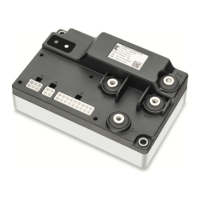8 — DIAGNOSTIC AND TROUBLESHOOTING
Curtis Model 1226 – September 2019
Return to TOC
pg. 76
External Status LED
One of the controller’s LED drivers can be used to display fault codes with an LED in the operator’s
control panel. During normal operation the status LED is steadily on.
If a fault is active, the external status LED continuously ashes the fault code until the fault is cleared.
e ash sequence operates as follows:
• e rst digit is flashed, with 0.13s between ashes.
• A 1.1s delay occurs.
• e second digit is ashed, with 0.13s between ashes.
• A 3.57s delay occurs, then the sequence repeats until the fault is cleared.
To enable the external status LED, you must congure the External Status LED Enable and External
Status LED Driver parameter. See pages 46 and 50 respectively.
Note: Vehicles can use the horn to sound the fault codes. To enable audible fault codes, set the Type
parameter on the Horn menu. See page 44.
Troubleshooting Faults
When the controller detects a fault, the controller operates in a manner that is safe in the presence of
that fault. Depending on the severity of the fault, the response can range from reduction of current
to complete shutdown of drive.
For example, when an EMR SRO fault occurs, the controller prevents the vehicle from unexpectedly
driving in emergency reverse if the emergency reverse switch is active when the keyswitch is turned
on.
Table 33 describes the fault codes and how to troubleshoot them.
Note: e Fault and Fault Action column includes both the fault name and the actions the controller
takes when the fault is detected.

